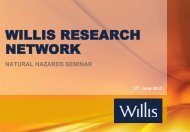Flood risk modelling for the United States - Willis Research Network
Flood risk modelling for the United States - Willis Research Network
Flood risk modelling for the United States - Willis Research Network
You also want an ePaper? Increase the reach of your titles
YUMPU automatically turns print PDFs into web optimized ePapers that Google loves.
<strong>Flood</strong> <strong>risk</strong> <strong>modelling</strong> <strong>for</strong> <strong>the</strong><br />
<strong>United</strong> <strong>States</strong><br />
Prof. James Smith, Princeton University<br />
Dr. Gabriele Villarini, <strong>Willis</strong> <strong>Research</strong> Fellow, Princeton<br />
University<br />
Cat 3 Hurricane in <strong>the</strong> Nor<strong>the</strong>ast: <strong>Willis</strong> Insurer’s Summit: www.willisresearchnetwork.com
Tropical Cyclones<br />
and Annual <strong>Flood</strong><br />
Peaks<br />
Large spatial<br />
variability in flood<br />
hazards over <strong>the</strong><br />
eastern US.<br />
Tropical Cyclone<br />
<strong>Flood</strong>s<br />
Thunderstorm<br />
<strong>Flood</strong>s<br />
Complex terrain – mountains<br />
and land water boundary<br />
Urbanization and <strong>the</strong> east<br />
coast megalopolis<br />
Multiple hazards – storm<br />
surge, wind, debris flows<br />
www.willisresearchnetwork.com
Extreme <strong>Flood</strong>s and<br />
Tropical Cyclones<br />
Hurricane Isabel<br />
18 September 2003<br />
Annual <strong>Flood</strong> Peak Discharge<br />
South Fork Shenandoah River<br />
Drainage Area: 1640 mi 2<br />
Record Length: 78 Years<br />
10 Year <strong>Flood</strong>: 47,500 ft 3 s -1<br />
100 Year <strong>Flood</strong>: 130,000 ft 3 s -1<br />
www.willisresearchnetwork.com
Tropical Cyclones<br />
and Annual <strong>Flood</strong><br />
Peaks<br />
572 USGS<br />
Streamflow<br />
Stations.<br />
More than<br />
75 year<br />
record<br />
length.<br />
North<br />
Atlantic<br />
Hurricane<br />
Data Base.<br />
www.willisresearchnetwork.com
Tropical Cyclone <strong>Flood</strong>s:<br />
% of Top 10<br />
Tropical cyclones<br />
dominate<br />
extreme floods in<br />
mid-Atlantic<br />
region.<br />
www.willisresearchnetwork.com
Isabel Rainfall (mm) – Wea<strong>the</strong>r<br />
<strong>Research</strong> and Forecasting (WRF)<br />
Model.<br />
Isabel Rainfall (mm) – NEXRAD<br />
Rainfall Observations<br />
www.willisresearchnetwork.com
Isabel – 19 September 2003<br />
0345<br />
UTC<br />
0351<br />
UTC<br />
0357<br />
UTC<br />
Rainbands and<br />
Urban <strong>Flood</strong>ing!<br />
0403<br />
UTC<br />
• Isabel – Baltimore,<br />
extreme rain rates, urban<br />
flooding, winds damage<br />
* Agnes – Baltimore (June<br />
1972), catastrophic<br />
flooding<br />
* TS Allison – Philadelphia,<br />
16 inches, 8 fatalities<br />
www.willisresearchnetwork.com
Chesapeake<br />
Bay Storm<br />
Surge Mesh<br />
Chesapeake Bay<br />
Isabel Storm Surge:<br />
* Model simulations<br />
(WRF + ADCIRC)<br />
underestimate peak<br />
water surface<br />
elevations<br />
* “Missing” Wind<br />
Observed<br />
Model<br />
www.willisresearchnetwork.com
Long Term Trends in<br />
Tropical Cyclone <strong>Flood</strong>s<br />
Nothing<br />
significant to<br />
report at this<br />
point…<br />
www.willisresearchnetwork.com
Interannual Variability of<br />
Tropical Cyclone <strong>Flood</strong>s<br />
Forecast skill: Using<br />
AMO, NAO and Nino<br />
3.4 indices.<br />
Forecast skill is<br />
similar to<br />
predictions <strong>for</strong><br />
landfalling tropical<br />
cyclones.<br />
www.willisresearchnetwork.com
“Envelope Curve”: <strong>Flood</strong> Peaks in <strong>the</strong> Eastern US<br />
“Three <strong>Flood</strong>s”<br />
1. Tropical Cyclones:<br />
Hurricane Agnes,<br />
June 1972.<br />
2. Winter-Spring<br />
Extratropical<br />
Storms: March<br />
1936<br />
3. Orographic<br />
Thunderstorm<br />
Systems:<br />
Smethport PA, 19<br />
July 1942.<br />
www.willisresearchnetwork.com
Thunderstorm Frequency – Catastrophic <strong>Flood</strong>s –<br />
Complex Terrain<br />
Lightning Strikes<br />
km -2 per year<br />
Largest rainfall<br />
accumulations in<br />
<strong>the</strong> world <strong>for</strong><br />
time periods less<br />
than 6 hours<br />
Loss of Life<br />
(Camille and<br />
Johnstown)<br />
Dam Failure<br />
Landslide and<br />
Debris Flow<br />
Hazards<br />
Urban <strong>Flood</strong>s<br />
www.willisresearchnetwork.com
Rapidan Storm – 27 June 1995<br />
“Terrain-locked”<br />
thunderstorm<br />
system<br />
Record Debris<br />
Flows <strong>for</strong><br />
Eastern US<br />
www.willisresearchnetwork.com
Rapidan Storm<br />
Simulation<br />
Regional<br />
episode of<br />
extreme<br />
rainfall,<br />
flooding and<br />
debris flows.<br />
Focusing of<br />
catastrophic<br />
rainfall in<br />
mountainous<br />
terrain not<br />
captured.<br />
“Hotspots” of<br />
catastrophic<br />
flood <strong>risk</strong><br />
www.willisresearchnetwork.com
Western vs Eastern <strong>Flood</strong>s<br />
(Appalachian Plateau vs Blue Ridge /<br />
Valley and Ridge)<br />
www.willisresearchnetwork.com
19 July 1996<br />
“19 July” Storms<br />
Smethport PA<br />
19 July 1942<br />
30.8 inches – 4 Hours<br />
1889 Rockport WVA<br />
1942 Smethport PA<br />
1977 Johnstown PA<br />
1996 Redbank Creek, PA<br />
www.willisresearchnetwork.com
July 19 Storms<br />
Seasonality of<br />
Heavy Rain<br />
Strong warm season<br />
extratropical systems<br />
July 1996:<br />
Seasonality of<br />
Thunderstorms<br />
16-17 <strong>Flood</strong>ing/Hail Iowa<br />
17-18 16 inches Chicago<br />
18-19 Appalachian <strong>Flood</strong>ing<br />
19-20 Maritime Provinces<br />
www.willisresearchnetwork.com
Warm Season Thunderstorms and<br />
Urban <strong>Flood</strong>ing<br />
Charlotte to<br />
New York City<br />
“Envelope<br />
Curve” flood<br />
peaks with<br />
modest return<br />
intervals.<br />
Rapidly<br />
changing<br />
flood hazards<br />
with<br />
urbanization<br />
www.willisresearchnetwork.com
<strong>Flood</strong> Frequency – Charlotte NC<br />
www.willisresearchnetwork.com
Storm total rainfall<br />
(mm)<br />
Storm<br />
Total<br />
Rain<br />
(mm)<br />
Storm Total<br />
Lightning<br />
(CG strikes<br />
km -2 )<br />
7 July 2004 - Dead Run<br />
Urban impacts<br />
of warm<br />
season<br />
thunderstorm<br />
systems<br />
www.willisresearchnetwork.com
Storm total rainfall<br />
(mm)<br />
Modeled<br />
Inundation<br />
<strong>Flood</strong><br />
Inundation<br />
Map<br />
<strong>Flood</strong> inundation modeling<br />
crucial <strong>for</strong> flood hazard<br />
assessment<br />
LISFLOOD (Paul Bates, WRN<br />
Bristol) provides key<br />
modeling tool<br />
www.willisresearchnetwork.com
Yellow – July 7 Inundation Area<br />
Light blue – FEMA 500-yr <strong>Flood</strong>plain<br />
Dark blue – FEMA 100-yr <strong>Flood</strong>plain<br />
www.willisresearchnetwork.com
NYC – 8 August 2007<br />
* Flash flooding and tornados<br />
* Supercell thunderstorms<br />
* Dallas Hailstorm (5 May<br />
1995), $1.2 billion flood and<br />
hail damage, 18 flash flood<br />
fatalities<br />
www.willisresearchnetwork.com
Summary and Conclusions<br />
* Tropical cyclones control extreme flooding in much of <strong>the</strong> eastern<br />
US; <strong>the</strong>re is pronounced spatial heterogeneity in tropical cyclone<br />
flooding.<br />
* Mountainous terrain plays a central role in determining <strong>the</strong> spatial<br />
variation of flood hazards in <strong>the</strong> eastern US.<br />
* Thunderstorm systems in mountainous terrain of <strong>the</strong> eastern US<br />
have produced some of <strong>the</strong> largest rainfall accumulations in <strong>the</strong> world<br />
<strong>for</strong> time intervals less than 6 hours.<br />
* Envelope curve of flood peak magnitudes <strong>for</strong> <strong>the</strong> eastern US<br />
includes numerous urban floods with relatively short return intervals.<br />
•“Climatology” of urban floods is closely linked to <strong>the</strong> climatology of<br />
warm season thunderstorm systems.<br />
www.willisresearchnetwork.com
<strong>Willis</strong> <strong>Research</strong> <strong>Network</strong><br />
www.willisresearchnetwork.com




